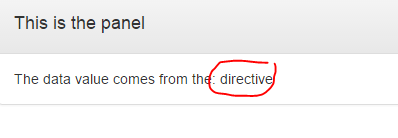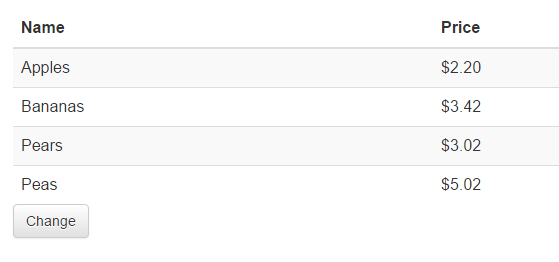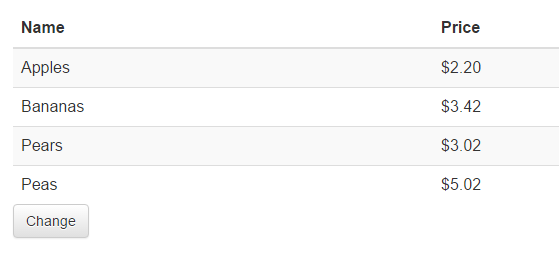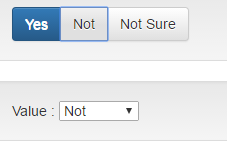学习要点:
- 嵌入包含
- 在指令中使用控制器
- 自定义表单元素
一、嵌入包含
嵌入包含是指将一个文档的一部分通过引用插入到另一个文档中
使用嵌入包含需要两个特定的步骤:
第一步:在创建指令时将transclude定义属性设置为true
第二步:将ng-transclude指令使用到模板中,就放入想插入被包装元素的地方
1.先看一个案例
<!DOCTYPE>
<!-- use module -->
<html ng-app="exampleApp">
<head>
<title>Angluar test</title>
<meta charset="utf-8"/>
<link rel="stylesheet" type="text/css" href="css/bootstrap.min.css">
<link rel="stylesheet" type="text/css" href="css/bootstrap-theme.min.css">
</head>
<body ng-controller="defaultCtrl">
<!-- 将panel标签中的内容放入到下面模板的panel-body中 -->
<panel>
The data value comes from the: {{dataSource}}
</panel>
<script type="text/javascript" src="js/angular.min.js"></script>
<script type="text/ng-template" id="template">
<div class="panel panel-default">
<div class=" panel-heading">
<h4>This is the panel</h4>
</div>
<div class=" panel-body" ng-transclude>
<!-- 在此处插入想插入的元素,即上面定义的<panel>标签-->
</div>
</div>
</script>
<script type="text/javascript">
angular.module("exampleApp", [])
.directive("panel", function () {
return {
// link : 为指令指定连接函数
link: function (scope, element, attrs) {
scope.dataSource = "directive";
},
// restrict : 指定指令如何使用 ECMA 元素、类、注释和属性, 类和注释一般不用
restrict : "E",
// 为每个实例创建一个作用域----但这里是被嵌入包含中的表达式
// 当为true时,scope.dataSource==controller
// 当为false时,scope.dataSource==directive
// 因为被嵌入包含的内容中的表达式是在控制器作用域被计算的,并非指令的作用域
scope : true,
// 指定指令模板
template : function () {
return angular.element(document.querySelector("#template")).html();
},
// transclude : 指定指令是否被用于包含任意内容
transclude : true
}
})
.controller("defaultCtrl", function ($scope) {
$scope.dataSource = "controller";
})
</script>
</body>
</html>
注意:在嵌入的内容中我们使用了内联的数据绑定
The data value comes from the: {{dataSource}}这样做主要说明的是:被嵌入包含内容中的表达式是在控制器中被计算的,并非在指令的作用域。
这句话的意思就是:上述的dataSource的值直接受控制器的影响,而不是受指令作用域的影响。在本案例中,控制器的dataSource=controller,在指令中dataSource=directive,显然dataSource最终显示为controller
当然,如果你想让指令作用域也在考虑之内,那么可以将定义指令中的scope设置为false

2.使用编译函数
什么时候使用编译函数?
当指令特别复杂或者需要处理大量数据的时候,我们可以使用编译函数操作DOM,而让链接函数执行其他任务。这样不仅提高性能,而且可以使用嵌入包含来重复生成内容的能力
<!DOCTYPE>
<!-- use module -->
<html ng-app="exampleApp">
<head>
<title>Angluar test</title>
<meta charset="utf-8"/>
<link rel="stylesheet" type="text/css" href="css/bootstrap.min.css">
<link rel="stylesheet" type="text/css" href="css/bootstrap-theme.min.css">
</head>
<body ng-controller="defaultCtrl" class="panel panel-body">
<table class="table table-striped">
<thead><tr><th>Name</th><th>Price</th></tr></thead>
<tbody>
<tr simple-repeater source="products" item-name="item">
<td>{{item.name}}</td>
<td>{{item.price | currency}}</td>
</tr>
</tbody>
</table>
<!-- 单击按钮,添加商品,提高价格 -->
<buton class="btn btn-default text" ng-click="changeData()">Change</buton>
<script type="text/javascript" src="js/angular.min.js"></script>
<script type="text/javascript">
angular.module("exampleApp", [])
.directive("simpleRepeater", function () {
return {
// 隔离作用域,且进行数据绑定
scope : {
// 双向数据绑定
data : "=source",
// 单向数据绑定
propName : "@itemName"
},
// element : 表示元素本身被包括到嵌入内容中,并非是其内容
transclude : 'element',
// 编译函数
compile : function (element, attrs, transcludeFn) {
return function ($scope, $element, $attr) {
// 添加监听器,当产品的数量发生改变,就会触发后面的工厂函数
$scope.$watch("data.length", function () {
// 移除子元素
var parent = element.parent();
parent.children().remove();
for (var i = 0; i < $scope.data.length; i++) {
// 创建一个新的作用域
var childScope = $scope.$new();
// 赋予每个实例item属性
childScope[$scope.propName] = $scope.data[i];
// 进行克隆数据
transcludeFn(childScope, function (clone) {
parent.append(clone);
})
}
})
}
}
}
})
.controller("defaultCtrl", function ($scope) {
// 数据模型
$scope.products = [
{ name: "Apples", price: 1.20 },
{ name: "Bananas", price: 2.42 },
{ name: "Pears", price: 2.02 }
];
// 添加商品,递增价格
$scope.changeData = function () {
$scope.products.push({ name : "Peas", price : 4.02});
for ( var i = 0; i < $scope.products.length; i++) {
$scope.products[i].price++;
}
}
})
</script>
</body>
</html>
二、在指令中使用控制器
指令中可以创建被其他指令所用的控制器
<!DOCTYPE>
<!-- use module -->
<html ng-app="exampleApp">
<head>
<title>Angluar test</title>
<meta charset="utf-8"/>
<link rel="stylesheet" type="text/css" href="css/bootstrap.min.css">
<link rel="stylesheet" type="text/css" href="css/bootstrap-theme.min.css">
</head>
<body ng-controller="defaultCtrl">
<div class="panel panel-default">
<!-- 嵌入内容ng-transclude -->
<!-- 双向数据绑定 product-table="totalValue"(绑定产品) product-data="products"(绑定产品质量和) -->
<table class="table table-striped" product-table="totalValue" product-data="products" ng-transclude>
<tr><th>Name</th><th>Quantity</th></tr>
<tr ng-repeat="item in products" product-item></tr>
<tr><th>Total:</th><td>{{totalValue}}</td></tr>
<!-- 嵌入内容ng-transclude -->
<!-- 双向数据绑定 product-data="products"(绑定产品) property-name="quantity" -->
<tr reset-totals product-data="products" property-name="quantity"></tr>
</table>
</div>
<script type="text/javascript" src="js/angular.min.js"></script>
<!-- 定义模板 -->
<script type="text/ng-template" id="productTpl">
<td>{{item.name}}</td>
<td><input ng-model='item.quantity' /></td>
</script>
<script type="text/ng-template" id="resetTpl">
<td colspan="2"><button ng-click="reset()">Reset</button></td>
</script>
<script type="text/javascript">
angular.module("exampleApp", [])
.directive("productItem", function () {
return {
template : document.querySelector("#productTpl").outerText,
// 声明对某个控制器的依赖,这里是productTable指令中的控制器
// require属性值的前缀
// None 表示假定两个指令都应用于同一元素
// ^ 表示在指令所应用到的元素的父元素上查找另一个指令
// 表示如果找不到指令就不报错
require : "^productTable",
link : function (scope, element, attrs, ctrl) {
scope.$watch("item.quantity", function () {
// 使用productTable 指令中的控制器
ctrl.updateTotal();
});
}
}
})
.directive("productTable", function () {
return {
transclude : true,
scope: {
// 这里的value表示计算的产品数量和
value : "=productTable",
// 这里的data相当于控制器中的products
data : "=productData"
},
// 创建控制器,可以被另外的两个指令使用
// 功能:累计求产品数量和
controller : function ($scope, $element, $attrs) {
this.updateTotal = function () {
var total = 0;
for (var i = 0; i < $scope.data.length; i++ ) {
total += Number($scope.data[i].quantity);
}
$scope.value = total;
}
}
}
})
.directive("resetTotals", function () {
return {
scope : {
// 这里的data相当于控制器中的products
data : "=productData",
// 这里的propname,相当于products.quantity
propname : "@propertyName"
},
template : document.querySelector("#resetTpl").outerText,
require : "^productTable",
link : function (scope, element, attrs, ctrl) {
scope.reset = function () {
for (var i = 0; i < scope.data.length; i++) {
scope.data[i][scope.propname] = 0;
}
// 使用productTable 指令中的控制器
ctrl.updateTotal();
}
}
}
})
.controller("defaultCtrl", function ($scope) {
$scope.products = [
{ name: "Apples", price: 1.20, quantity: 2 },
{ name: "Bananas", price: 2.42, quantity: 3 },
{ name: "Pears", price: 2.02, quantity: 1 }
];
})
</script>
</body>
</html>
三、创建自定义表单元素
<!DOCTYPE>
<!-- use module -->
<html ng-app="exampleApp">
<head>
<title>Angluar test</title>
<meta charset="utf-8"/>
<link rel="stylesheet" type="text/css" href="css/bootstrap.min.css">
<link rel="stylesheet" type="text/css" href="css/bootstrap-theme.min.css">
</head>
<body ng-controller="defaultCtrl">
<div><tri-button ng-model="dataValue"/></tri-button></div>
<div class="well">
Value :
<select ng-model="dataValue">
<option>Yes</option>
<option>Not</option>
<option>Not Sure</option>
<option>Huh</option>
</select>
</div>
<script type="text/javascript" src="js/angular.min.js"></script>
<script type="text/ng-template" id="triTpl">
<div class="well">
<div class="btn-group">
<button class="btn btn-default">Yes</button>
<button class="btn btn-default">Not</button>
<button class="btn btn-default">Not Sure</button>
</div>
</div>
</script>
<script type="text/javascript">
angular.module("exampleApp", [])
.controller("defaultCtrl", function ($scope) {
$scope.dataValue = "Not Sure";
})
.directive("triButton", function () {
return {
// 表示该指令只能被当作元素使用
restrict : "E",
// 声明了对ng-model的依赖
require : "ngModel",
// 调用模板--生成内容
template : document.querySelector("#triTpl").outerText,
// 链接函数
// ctrl应用指令的元素的抽象集合
link : function (scope, element, attrs, ctrl) {
// 为每个按钮元素添加点击事件
// $scope.dataValue 的值随按钮值的变化
element.on("click", function (event) {
scope.$apply(function () {
// $setViewValue : 更新数据绑定的值
ctrl.$setViewValue(event.target.innerText);
});
});
// $formatters : 将$modelValue 转成 $viewVlaue的格式化函数构成的数组
// $modelValue 表示从作用域返回为格式化的值
// $viewValue 表示返回应当被指令显示的格式化后的值
ctrl.$formatters.push(function (value) {
return value == "Huh" "Not Sure" : value;
});
// 函数表达式
// 为选择的按钮添加样式
var setSelected = function (value) {
var buttons = element.find("button");
buttons.removeClass("btn-primary");
for ( var i = 0; i < buttons.length; i++) {
if (buttons.eq(i).text() == value) {
buttons.eq(i).addClass("btn-primary");
}
}
}
// $render : 这是当数据绑定的值发生变化时NgModel控制器调用更新UI的函数
ctrl.$render = function () {
// $viewValue : 返回应当被指令显示的格式化后的值
setSelected(ctrl.$viewValue || "Not Sure");
}
}
}
})
</script>
</body>
</html>
- 顶
- 0
- 踩
- 0